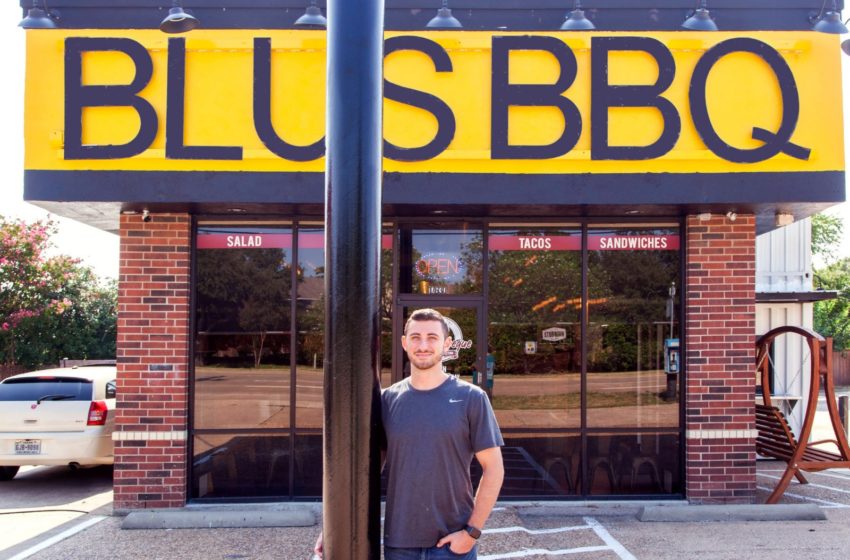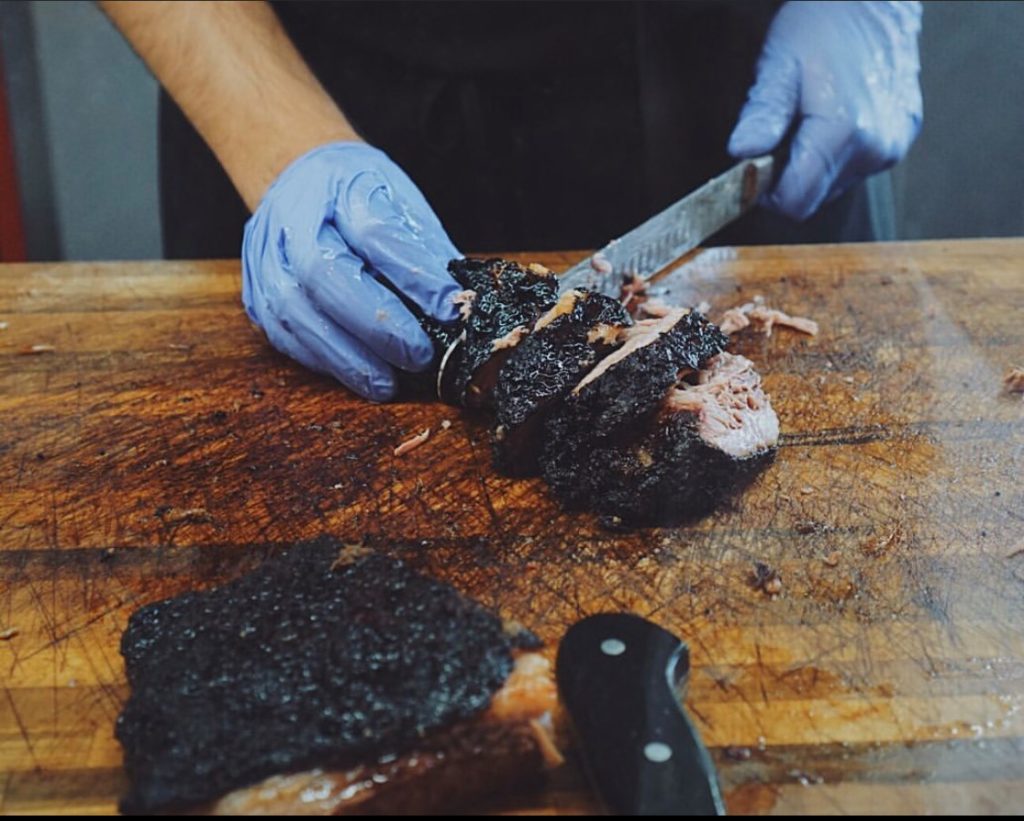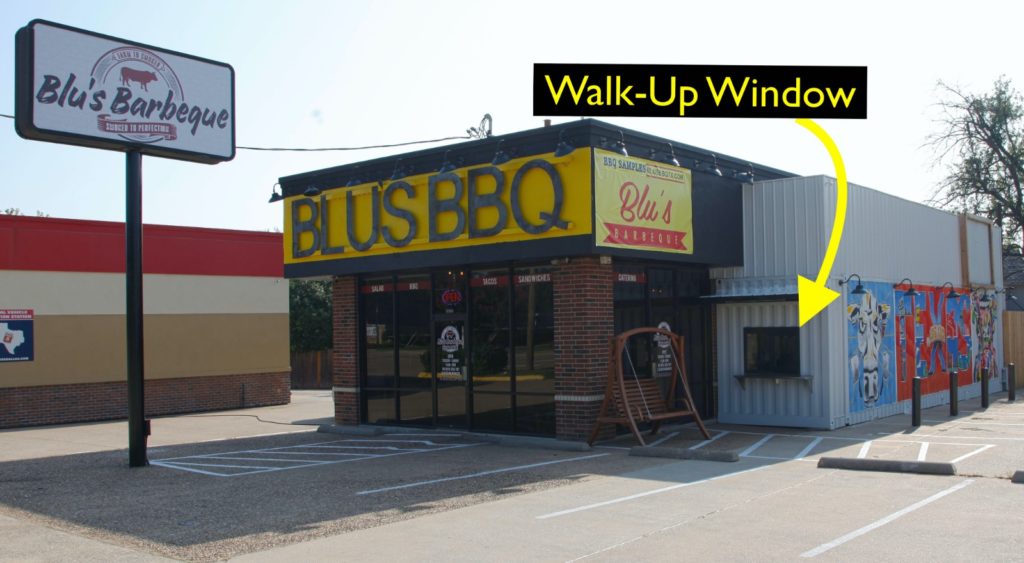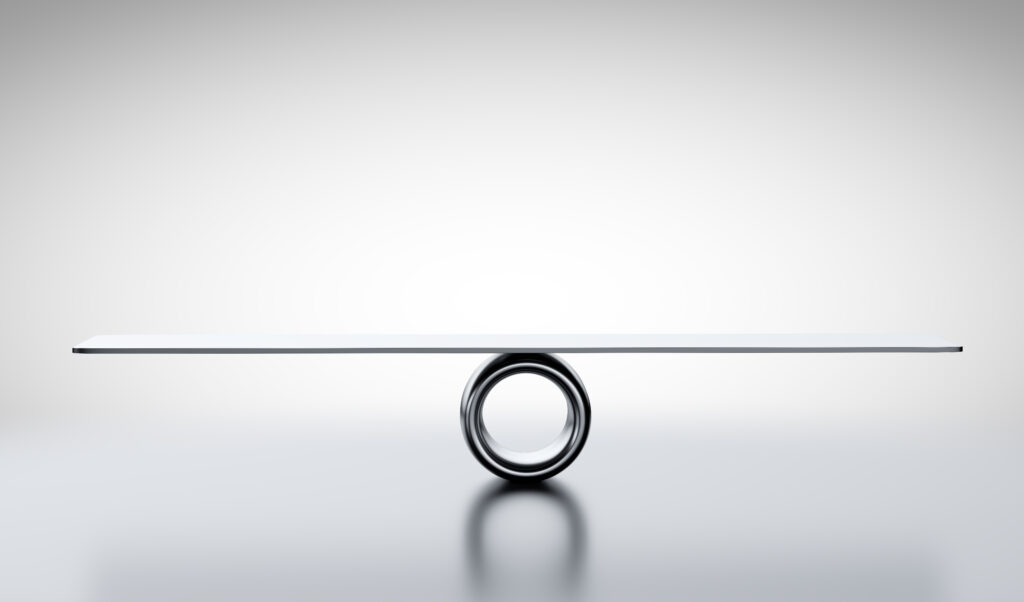How One Barbeque Joint Adapted—and Succeeded—During the Pandemic

In Dallas, as in most of Texas, you can find barbeque pretty easily. But it’s a little harder to find a great barbeque joint that offers all the homemade sides and rubs. When I started Blu’s Barbeque last year at the age of 24, I wanted to give more people that full experience. I’d been interested in barbeque since I started playing around with my first pit in Lubbock in 2014. My first few briskets weren’t great, but after I honed my skills and saw some success in catering, Blu’s seemed like the perfect way to flex my entrepreneurial muscles.
Things went well. We opened in the summer of 2019 with a converted shipping container for a kitchen, in the North Dallas spot where I used to get my hair cut. Our menu featured Angus beef brisket, Wagyu ribs, classic sides (coleslaw, five-cheese mac and cheese, baked beans, etc.), and some more adventurous specials to keep things interesting (incorporating everything from smoked salmon to alligator to venison).

I got to know many of my thousands of loyal customers, and they came to feel like part of the Blu’s family. They got to know me too, on a first-name basis, and today they feel comfortable sharing their latest stories and challenges when they’re in to grab their barbeque. The Dallas Observer even named us to their top-five barbeque list.
But Blu’s hadn’t even been open a year before we saw a storm gathering on the horizon.
The Turbulent Spring
As an entrepreneur, restaurateur, rancher, and cryptocurrency day trader, I’m used to taking risks and “thinking outside the box.” But COVID-19 tested me like I’d never been tested before. Facing an uncertain future, we decided to make quick operational changes at Blu’s, with the hope that we could keep serving our customers and keep everyone safe in the process. By mid-March, we were in what we called Restaurant Survival Mode. We changed how we did everything from customer interaction to marketing to purchasing.
Below, I want to share some of what we did, and continue to do, not only because these interventions worked for us—but because they reflect how restaurant operators might think about serving customers in a post-COVID environment. Like many others, I believe the effects of this pandemic will be with us for the foreseeable future, especially in the world of restaurants. That will require many of us to think and act differently.
A Walk-Up Window of Opportunity
As the first step in Restaurant Survival Mode, we immediately closed the Blu’s dining room—even prior to the government-mandated shutdown. No traffic was permitted in the building other than staff. To make business still possible, we quickly installed a walk-up window and interacted with customers exclusively through that window. When people showed up, we provided them with a short note explaining our precautions. People immediately caught on, and the reaction was overwhelmingly positive.
We initially thought that our biggest challenge would be doing enough business to stay open, but instead it was learning how to serve hundreds of customers each day through a single walkup window—and do it safely. When people drove by and saw 30 or more customers waiting to order barbeque, we wanted them to see our customers respecting the rules of social distancing and feel like they could order from Blu’s and still feel safe. (It didn’t hurt that the visual of those long lines also brought in new customers.)
In the first weeks of the shutdown, 72 percent of our customers were placing their orders online and choosing the day and time they’d like to pick it up at our walk-up window. The remaining 28 percent of sales were transacted onsite using a handheld POS device (disinfected after each transaction), which kept person-to-person interaction to a minimum.
The installation of the walkup window turned out to be a great decision. It paid for itself in one day of sales, and our clients appreciated having that sense of safety during a time when everyone was on edge. We strictly enforced the rules, too, even during the busiest times. Today, Blu’s customers still love the convenience and one-to-one personal interaction of the window, especially compared to impersonal drive-through intercom systems.

Doubling Down
We also knew that Restaurant Survival Mode needed to include marketing. While much of the industry scaled back marketing efforts or waited to see how this whole pandemic thing would pan out, we doubled down—literally.
We immediately started spending twice what we were before on advertising. We developed 16 promotional discount codes, redeemable only online, that we marketed directly to our customer base. The great expenses we incurred required us to plan carefully, but we significantly exceeded our stated goals, serving more than 200 customers daily during the heart of the shutdown. From an ROI perspective, the investment in additional marketing and advertising paid off.
What about delivery, which for a while seemed like it was becoming a national pastime? We made sure we were fully partnered with services like Grubhub, Uber Eats and DoorDash. While we prefer to cut the meats to order in front of our customers, we knew that people needed delivery options—and these services are a good way to bring in new customers as well. Through the midst of the crisis, each customer who placed an order through one of these platforms received a gift card to entice them to stop by and purchase from us directly in the future.
To our greater advertising spend we added a dash of creativity and a “get it done” approach. We put our heads together and came up with new ways to meet customer needs. For example, we took on more catering orders, many from medical providers and small businesses. We also started a bulk sales program for chilled meat. That program exceeded our expectations, and we sold hundreds of pounds of chilled smoked meats—something we had never done before. People were uneasy about the economy and the safety of going out, and were quick to jump at the opportunity to stock up on high-quality smoked meat they only had to warm up.
Needless to say, all of this required that we secure our inventory. As the concerns about the virus spread, our supply chain practically collapsed. The largest meatpackers would soon close their plants. Fortunately, we foresaw this in time and purchased about a ton of meat beforehand and secured ample cold storage space for all those ribs, briskets, chickens, turkeys, and more. That supply enabled us to deliver consistently to our customer base and the people of North Dallas.
Changes Worth Keeping—Long After the Pandemic
In May, Texas authorized restaurants to open back up with limited dining capacity. But Blu’s Barbeque decided to keep its dining room closed a while longer. We’d received no pushback from our thousands of loyal customers—why try and pivot now? We felt that prematurely changing a great process could come back to harm us. (Though, of course, a reopened dining room was on the horizon.)
As a young entrepreneur, 2020 has been a major learning curve for me, but Blu’s has grown so much in that time. I’ve enjoyed talking with other restaurant operators about how we can keep action plans in place and adapt quickly and creatively to new situations, and I hope to have more of those conversations. For my part, the lessons we have learned through the COVID-19 crisis will inform how we operate going forward.
Not only will many of the changes continue to help us meet customer needs in the era of continued social distancing, but the necessity of strong planning and quick action are now deeply ingrained in my makeup as an entrepreneur.
Above all, this pandemic has shown me how valuable customer trust is, and how important it is to meet your community members and communicate with them. Moving forward, I will be making that extra effort to answer people’s questions, get to know them on a personal level, and ensure the quality of our service. I want our customers to have no doubt of our loyalty to being the best.
And our walkup window? It’s there for good.
Restaurant Leadership Through COVID-19 and Beyond
As the industry recalibrates to handle the pandemic and the inevitable recovery, here are some suggestions based on our experience at Blu’s.
- Expand lines of communication. Make your restaurant more accessible to customers, whether they have questions or comments or just want to talk to you. In recent months, we’ve expanded both two-way communication channels with our customers. We installed multiple phone lines, began using text messaging (inbound and outbound), and enhanced our social media for better real-time communication. If you can make it easier for customers to place an order or have a question answered, they’re going to appreciate it, especially now.
- Prioritize marketing. Don’t let marketing be the first budget item that gets slashed, and don’t get stuck in the rut of doing what you’ve always done. It shouldn’t take a pandemic to start getting creative with marketing; you should be doing it constantly.
- Consider walk-up options. In Texas, most restaurant operators are able to offer walk-up options effectively. Walk-up windows allow for safe transactions, friendly person-to-person interaction, and plenty of foot traffic—without bringing that traffic indoors. As COVID-19 makes us all more conscious of social distancing, many people will prefer low-contact setups such as walk-up windows.
- You don’t have to go with the flow. Just because things are done a certain way, it doesn’t mean you must adapt. We decided to keep our dining room closed even after the May announcements, and it didn’t hurt us. Keep your best interests in mind—remembering that they aren’t always the same as what’s good for other businesses!






